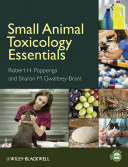Small Animal Toxicology Essentials

Providing a ready reference for the initial triage, collection of diagnostic samples, and management of a poisoning case, Small Animal Toxicology Essentials focuses on the most common poisons encountered by companion animals. From prevention to evaluation, monitoring, and treatment, the book is a guide for veterinary technicians to differentiate between significant and insignificant exposures and effectively manage animal poisonings.
Emphasizing clinical signs, differential diagnoses, and case management, the book begins with the principles of veterinary toxicology, such as terminology, history-taking, and decontamination. The second half of the book is devoted to specific toxicants, including plants, metals, drugs, and household poisons. A companion website at www.wiley.com/go/poppenga provides review questions in Word and color images available for download into PowerPoint. Small Animal Toxicology Essentials is a useful resource for veterinary technicians, especially those with a interest in emergency and critical care, and veterinary technician students, as well as practicing veterinarians looking for an introduction to toxicology.
Autor: Robert H. Poppenga, D.V.M., Ph.D., DABVT, is a Professor and Head of the Toxicology Section at the California Animal Health and Food Safety Laboratory System at the School of Veterinary Medicine, University of California, Davis. Sharon M. Gwaltney-Brant, D.V.M., Ph.D., DABVT, DABT, is a Toxicology Consultant for Veterinary Information Network (VIN) and Adjunct Instructor at the College of Veterinary Medicine, University of Illinois at Urbana-Champaign, Urbana, Illinois
| Nakladatel | Plot |
|---|---|
| ISBN | 9780813815381 |
| Vydání | 2011 |
| Vazba | brožovaná |
| Počet stran | 336 |
Small Animal Toxicology Essentials is a thorough introduction to the principles of veterinary toxicology. Providing a ready reference for the initial triage, collection of diagnostic samples, and management of a poisoning case, the book focuses on the most common poisons encountered by companion animals. From prevention to evaluation, monitoring, and treatment, Small Animal Toxicology Essentials is a guide for veterinary technicians to differentiate between significant and insignificant exposures and effectively manage animal poisonings.
Emphasizing clinical signs, differential diagnoses, and case management, the book includes sections on the fundamentals of veterinary toxicology, the approach to a poisoned patient by body system, and specific toxicants likely to be encountered. Small Animal Toxicology Essentials is a useful resource for veterinary technicians, especially those with an interest in emergency and critical care, and veterinary technician students, as well as veterinarians looking for an introduction to toxicology.
Outlines toxicology basics, from prevention to evaluation, monitoring, and treatment.
Focuses on nursing care following exposure to the most common poisons seen in small animal practice.
Emphasizes practical, clinically relevant information such as presenting signs, differential diagnoses, and case management.
Provides guidance on both the general approach to a poisoned patient and specific poisons.
Includes access to a companion website providing review questions available for download into Word and color images available for download into PowerPoint at www.wiley.com/go/poppenga.
| Preface. | XI |
| Contributors. | XII |
| Section 1: Fundamentals of Veterinary Clinical Toxicology. | 3 |
| 1 General Toxicologic Principles (Sharon Gwaltney-Brant and Robert H. Poppenga). | 5 |
| 2 Incidence of Poisoning in Small Animals (Sharon Gwaltney-Brant). | 17 |
| 3 Toxicology Information Resources (Sharon Gwaltney-Brant). | 21 |
| 4 Taking a Toxicologic History (Carrie Lohmeyer). | 27 |
| 5 Essential Calculations (Camille DeClementi). | 33 |
| 6 Initial Management of Acute Intoxications (Elisa Petrollini-Rogers and Bridget McNally). | 43 |
| 7 Decontamination Procedures (Lisa Murphy). | 51 |
| 8 Antidotes (Tina Wismer). | 57 |
| 9 Investigating Fatal Suspected Poisonings (Safdar A. Khan). | 71 |
| 10 Toxicologic Testing and Using Diagnostic Laboratories (Lisa Murphy). | 77 |
| Section 2: A Systems-Affected Approach to Toxicology. | 81 |
| 11 Nervous System (Tina Wismer). | 83 |
| 12 Cardiovascular System (Karla R. Smith). | 89 |
| 13 Pulmonary System (John A. Pickrell, Kiran Dhakal, and Sharon Gwaltney-Brant). | 95 |
| 14 Hepatobiliary System (Sharon Gwaltney-Brant). | 99 |
| 15 Urinary System (Erin Freed). | 105 |
| 16 Other Systems (Sharon Gwaltney-Brant). | 109 |
| Section 3: Specific Toxicants. | 115 |
| 17 Rodenticides (Eric Dunayer). | 117 |
| 18 Insecticides (Petra A. Volmer). | 127 |
| 19 Other Pesticides (Robert H. Poppenga). | 137 |
| 20 Plants (Joanna Delaporte and Charlotte Means). | 147 |
| 21 Dietary Supplements and Herbs (Charlotte Means). | 161 |
| 22 Zootoxins (Tamara Foss). | 171 |
| 23 Mycotoxins and Mushrooms (Joyce Eisold and Michelle Mostrom). | 189 |
| 24 Food-Associated Intoxications (Mindy Bough). | 207 |
| 25 Drugs of Abuse (Sharon Gwaltney-Brant). | 221 |
| 26 OTC Drugs (Mary M. Schell and Sharon Gwaltney-Brant). | 231 |
| 27 Prescription Drugs (Sharon Gwaltney-Brant). | 241 |
| 28 Household and Industrial Toxicants (Rhian Cope). | 253 |
| 29 Metals and Minerals (Robert H. Poppenga). | 273 |
| 30 Miscellaneous Toxicants (Michelle Mostrom). | 285 |
| Appendices. | 301 |
| Appendix 1: Drugs Used in Toxicology (Sharon Gwaltney-Brant). | 303 |
| Appendix 2: Additional Toxic Plants and Associated System-Based Effects (Joanna Delaporte and Charlotte Means). | 311 |
| Appendix 3: Plants Not Reported to Be Toxic (Joanna Delaporte and Charlotte Means). | 321 |
| Index | 329 |